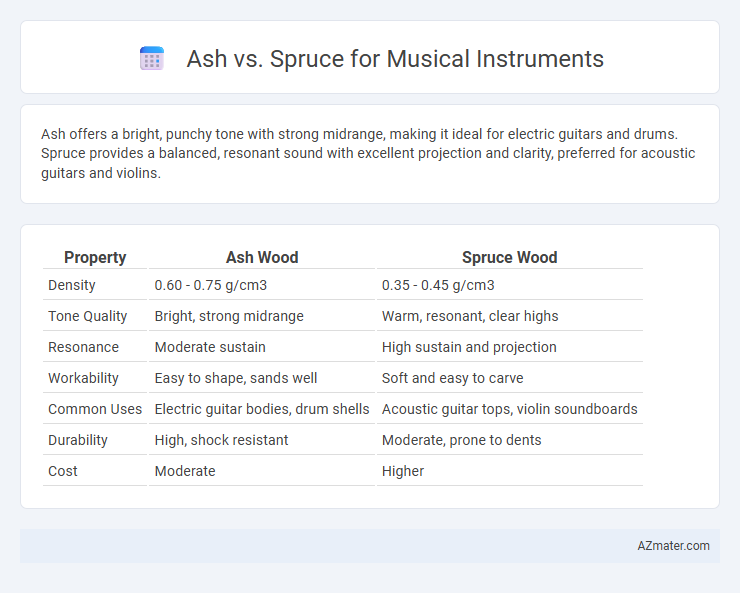Ash offers a bright, punchy tone with strong midrange, making it ideal for electric guitars and drums. Spruce provides a balanced, resonant sound with excellent projection and clarity, preferred for acoustic guitars and violins.
Table of Comparison
| Property | Ash Wood | Spruce Wood |
|---|---|---|
| Density | 0.60 - 0.75 g/cm3 | 0.35 - 0.45 g/cm3 |
| Tone Quality | Bright, strong midrange | Warm, resonant, clear highs |
| Resonance | Moderate sustain | High sustain and projection |
| Workability | Easy to shape, sands well | Soft and easy to carve |
| Common Uses | Electric guitar bodies, drum shells | Acoustic guitar tops, violin soundboards |
| Durability | High, shock resistant | Moderate, prone to dents |
| Cost | Moderate | Higher |
Introduction to Ash and Spruce in Musical Instrument Making
Ash wood offers exceptional resonance and bright tonal qualities, commonly favored for electric guitar bodies due to its strong grain and durability. Spruce is highly regarded for acoustic instrument soundboards, prized for its superior strength-to-weight ratio and ability to produce clear, vibrant tones. Both woods contribute distinct acoustic properties, making them essential choices in crafting high-quality musical instruments.
Botanical and Physical Characteristics
Ash wood, derived from the Fraxinus genus, is characterized by its light color, straight grain, and excellent shock resistance, making it a popular choice for electric guitar bodies due to its bright tone and strong sustain. Spruce, primarily from the Picea genus, is renowned for its lightweight, fine-grained, and resonant qualities, commonly used for acoustic instrument soundboards because of its superior stiffness-to-weight ratio and clear, responsive tonal properties. Both woods offer distinct botanical and physical traits that influence their acoustic performance and durability in musical instruments.
Tonal Qualities of Ash vs Spruce
Ash wood produces a bright, snappy tone with strong midrange presence and excellent sustain, making it ideal for electric guitars needing clarity and punch. Spruce offers a well-balanced tonal range characterized by clear highs, rich lows, and robust projection, often preferred for acoustic instruments due to its responsiveness and dynamic range. Comparing tonal qualities, ash delivers more pronounced attack and brightness, while spruce provides warmth and versatility across musical styles.
Durability and Longevity Comparison
Ash wood is highly durable and resistant to wear, making it an excellent choice for musical instruments that endure frequent handling and impact, such as electric guitar bodies. Spruce, while prized for its tonal qualities in acoustic instruments, is softer and less resistant to dents and scratches, which may affect its longevity under heavy use. Instruments made from ash generally offer greater structural resilience and prolonged lifespan compared to spruce, which requires careful maintenance to preserve its integrity over time.
Workability and Craftsmanship Considerations
Ash offers excellent workability with its straight grain and moderate density, making it ideal for crafting detailed guitar bodies and providing a balanced tone with pronounced mids. Spruce, prized for its lightweight and fine grain, excels in soundboard construction due to its high stiffness-to-weight ratio, enhancing resonance and projection in acoustic instruments. Craftsmanship with ash emphasizes durability and aesthetic appeal through distinct grain patterns, while spruce demands precision in shaping and bracing to maximize acoustic performance.
Common Instruments Using Ash and Spruce
Common musical instruments using ash include electric guitars and basses due to its bright tone and strong grain pattern, providing durability and aesthetic appeal. Spruce is predominantly used for acoustic guitar tops, violins, and pianos, valued for its excellent resonance and superior sound projection. Both woods contribute distinct sonic qualities, with ash delivering a crisp sound and spruce offering warmth and clarity.
Cost and Availability in the Market
Ash wood generally costs less than spruce, making it a more budget-friendly option for musical instruments. Spruce, prized for its superior tonal qualities in soundboards, often commands higher prices and can be less readily available due to demand and slower growth rates. Market availability of ash is typically higher, supported by abundant supply and faster growth, whereas spruce availability can fluctuate based on regional forestry regulations and harvesting restrictions.
Environmental Impact and Sustainability
Ash wood is favored for musical instruments due to its fast growth rate and widespread availability, contributing to lower environmental impact and improved sustainability compared to slower-growing species. Spruce, commonly used for soundboards, requires old-growth trees that take decades to mature, raising concerns about deforestation and habitat loss. Sustainable sourcing certifications and responsible forest management practices are critical for both ash and spruce to minimize ecological footprints in instrument production.
Player Preferences and Genre Suitability
Ash offers a bright, snappy tone with strong midrange presence, favored by players seeking clarity and punch in rock and blues genres. Spruce provides a balanced, resonant sound with excellent projection, making it ideal for acoustic and classical instruments preferred by fingerstyle and folk musicians. Player preference often depends on tonal brightness versus warmth, with ash suited for energetic performances and spruce for nuanced, expressive playing.
Choosing the Right Wood for Your Instrument
Ash and spruce are popular tonewoods for musical instruments due to their distinctive acoustic properties; ash offers bright, snappy tones with strong sustain, ideal for electric guitar bodies. Spruce is favored for acoustic instrument soundboards because of its excellent strength-to-weight ratio, producing clear, resonant sound with rich harmonic overtones. Selecting the right wood depends on desired tonal characteristics, playability, and durability requirements specific to the instrument type.

Infographic: Ash vs Spruce for Musical Instrument
 azmater.com
azmater.com